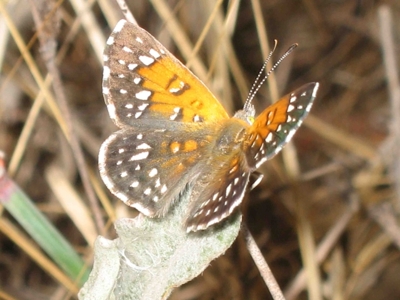Wild Equity Lawsuit Brings Millions of Dollars to Antioch’s Communities, Endangered Species



For Immediate Release, July 8, 2013
Contacts:
Brent Plater, Wild Equity Institute, (415) 572-6989
Shana Lazerow, Communities for a Better Environment, (510) 302-0430 × 18
Jonathan Evans, Center for Biological Diversity, (415) 436-9682 × 318
Legal Settlement Brings Millions of Dollars to
Antioch’s Communities and Endangered Species
ANTIOCH, Calif.— A legal settlement announced today requires a proposed natural gas-fired power plant to provide $2 million to mitigate pollution in low-income communities in Antioch and Oakley, Calif., as well as to mitigate harm to endangered species at the Antioch Dunes National Wildlife Refuge, the last home of the critically imperiled Lange’s Metalmark Butterfly.
The settlement is the result of the efforts of a coalition of conservation and community advocates led by the Wild Equity Institute, Communities for a Better Environment and the Center for Biological Diversity.

Lange’s Metalmark Butterfly photo © Liam O’Brien, http://sfbutterfly.com.
“Endangered species recovery efforts will take a giant leap forward and public health efforts in Antioch and Oakley will be recharged,” said Brent Plater, executive director of the Wild Equity Institute. “By bringing grassroots conservation and environmental justice concerns together, we’ve improved the well-being of us all.”
The funds will be distributed by the Rose Foundation for Communities & the Environment, and will support public-health programs offered by La Clinica de la Raza in nearby Oakley; endangered species recovery efforts implemented by the U.S. Fish and Wildlife Service at the Antioch Dunes Wildlife Refuge; and other local institutions. Funding will be made available as early as December, many months in advance of the Oakley Generating Station’s starting date, and will continue for the next 10 years.
“We’re honored to have the opportunity to reinvest these funds back into the local communities and ecosystems that are most impacted by the pollution,” said Tim Little, executive director of the Rose Foundation.
“The funds will allow us to work with our community to prevent, control, and manage public health illnesses, including asthma. By investing in prevention, we hope to improve the well-being of the communities we serve as well as decrease health care costs,” said Jane García, La Clínica’s CEO.
In the past several years, the California Energy Commission has authorized three new power plants within one mile of two existing power plants in Antioch. While the energy will be distributed to San Francisco and other urban areas, the concentrated emissions will threaten public health in nearby communities and push the Lange’s metalmark butterfly, whose last wild habitats will be partially surrounded by power plants, closer to extinction.
“This small area houses a disproportionately large number of power plants, each of which emits greenhouse gases and pollutants that are toxic both to the people who live, work and go to school near the plants, and the surrounding environment,” said Shana Lazerow, an attorney at Communities for a Better Environment.
The settlement resolves litigation brought under the Clean Air Act and the Endangered Species Act. The conservation organizations and community advocates asserted that the Oakley Generating Station would emit carbon- and nitrogen-based pollutants that would harm human health and endangered species, while contributing to global warming without the necessary permits required by two laws.
“The Lange’s metalmark butterfly is a Bay Area jewel that’s already way too close to extinction,” said Jonathan Evans, toxics and endangered species campaign director at the Center for Biological Diversity. “This agreement will help throw a lifeline to one of the world’s most endangered species.”
“For too long pollution from power plants has threatened local communities and the butterfly’s survival,” said Plater. “It’s time for our energy infrastructure to become part of the solution. We call on all of the power plants polluting Antioch and Oakley to contribute to a solution.”
Background on the Lange’s Metalmark Butterfly:
The Lange’s metalmark butterfly is a brightly colored, fragile and highly endangered butterfly that has been protected by the federal Endangered Species Act since 1976. The species is endemic to the Antioch Dunes in Contra Costa County, a relict desert landscape left behind as California’s prehistoric deserts retreated from the Bay Area 140,000 years ago. Because of the Antioch Dunes’ isolation, many species found there are unique and very rare.
The sole food plant for the Lange’s caterpillar is the naked-stemmed buckwheat, a native plant adapted to survive in the nutrient-poor soils found in the Antioch Dunes. The butterfly’s population is dependent on this plant, but nitrogen emissions from power plants are changing the chemical composition of the dune soil, and invasive weeds are now so common that they are crowding out the dune’s indigenous flora and fauna. The U.S. Fish and Wildlife Service has determined that nitrogen emissions from power plants near the dunes are “virtually certain” to cause harm to endangered species.
To find out more about Wild Equity’s work protecting Antioch’s communities and the Antioch Dunes National Wildlife Refuge visit https://www.wildequity.org/
The Wild Equity Institute is building a healthy and sustainable global community for people
and the plants and animals that accompany us on Earth.
https://www.wildequity.org/
###

Leave a Reply
Want to join the discussion?Feel free to contribute!